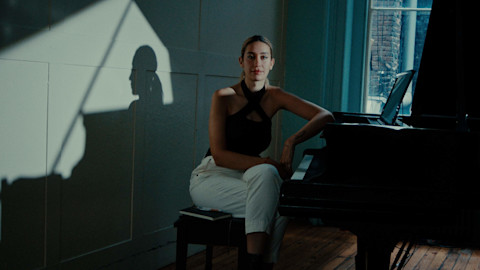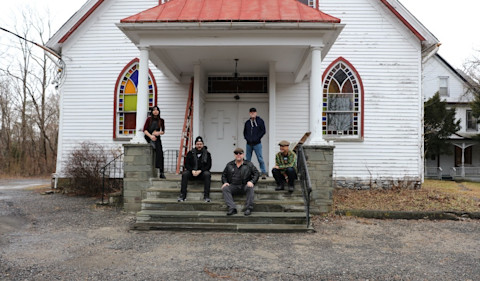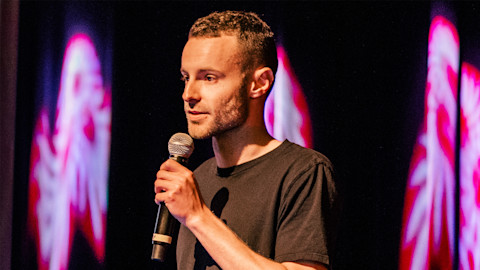Talking with the viral hitmakers about how they created their vibrant electro sound and what “Capsize” has meant to their career.
Last April, Brett Hite and James Sunderland were wondering how much longer their band Frenship was going to last. The pair had met at a Lululemon in Los Angeles, and they quickly went from co-workers to collaborators, releasing a string of synth-pop singles built around big hooks and irresistible grooves. Still, nothing was sticking.
Their luck changed with "Capsize." A collaboration with vocalist Emily Warren, it was uploaded to Spotify on April 16th, 2016. The song became one of the year's surprise hits, netting 20 million streams in its first month and 400 million to date. Frenship themselves were named Spotify's No. 2 breakout artist of the year.
Now, in 2017, the duo is turning that viral success into IRL fans. After playing summer festivals like Lollapalooza and Outside Lands, Frenship headlined a fall tour that included sold-out shows in Chicago and San Francisco, while working on an album they expect to release in 2018. Speaking over the phone, they chatted about the influence of Phil Collins and how a Spotify playlist changed their careers.
How did your sound evolve from when you first played tracks for each other to what we hear when we listen to your music today?
Brett Hite: Early on we fell into what we knew, which was James doing more of the producing. It leaned a little electronic—more than it does now, probably. I was probably writing more. We both really wanted to do what the other person was doing. I remember our voices being a big connecting piece. We thought that was cool, so we let that be our sound.
James Sunderland: I think our voices are the connective tissue. We do a lot of vocal stacking, like you hear in old songs. You listen to a Bee Gees song and you hear tons of layers of vocals. In ’70s and ’80s music, it's just stacks on stacks of vocals. I came from the dance world, so I pulled from that style of production early on. And Brett was a singer-songwriter, so, honestly, we just forced the two things together. Eventually we started pulling from a lot of big '80s bands: Phil Collins, Peter Gabriel, and some hip-hop. We'd ask each other, "Well, what did you listen to growing up?" Brett listened to a ton of rap, and had some Disturbed in there probably. (Laughs)
Hite: James had a lot of Creed. (Laughs)
Sunderland: Through that process you find where you meet in the middle.
__You're pulling from these ’80s artists, but when I listen to your music it still sounds very contemporary. It doesn't sound retro or nostalgic. How do you accomplish that? __
Sunderland: I think we refer to those ’80s songs a lot. "In the Air Tonight."
Hite: "I Can't Dance" by Genesis.
Sunderland: The choruses are so huge and anthemic. It's literally built for stadiums. That's a lot of what we feel and hear in that music. I think we have some big-sounding choruses that are full and stacked and hopefully can be played in an arena someday. We just love those ’80s gated snares and all that.
Looking back, it's impressive how quickly "Capsize" went viral. From your perspective, what did that look like?
Hite: We can't take any credit for it. (Laughs) It was a weird time for us. It was a tough time. We were kind of burned-out on the whole thing. We were fighting with each other. We had a publisher and lawyers, and that was the extent of our team. We didn't have anything bigger than that helping us release the music or put plans together. So we decided to throw some music out.
Sunderland: We did put a little money into PR. A friend of a friend had a little PR firm and got us on Hype Machine, basically. We did a song with this Norwegian DJ Matoma that did pretty well in the Hype Machine blog world, and when she worked "Capsize" it stayed at No. 1 on the Hype Machine chart for a couple days. From there, Spotify found it, and it got on New Music Friday. We thought we'd made it then and there, that was it. Then we got an email that said they were gonna try it out on Today's Top Hits, and it outperformed a lot of stuff. It went from there.
A lot of artists get a song onto a playlist and then struggle to figure out what’s next. You guys have built a fanbase, and you just toured. How have you guys achieved that?
Hite: It's still early, but I think a lot of it is that we didn't do that perfectly. If you look at the size of the songs and how big the fanbase is, comparatively, I don't think we did our best in achieving that. We weren't prepared at all for something like this to happen. We were about to break-up as a band. We didn't have any music videos. We barely had any press releases. And when it did happen, we didn't know how to scale with it.
Sunderland: We weren't even a live band yet. We're going on a 40-date headline tour next year, and these types of rooms are the rooms we probably should have been doing right as "Capsize" was peaking at Spotify and at radio. There's a five-to-six month period where, as a new artist, if your song goes, you really should be prepared to support it on the live side. That's a huge place to make those lifetime fans.
Hite: There are tools, like Spotify pre-sales for tours, that we didn't know about at the time. These are ways that Spotify can help sell a tour and get real people coming to the shows. We're absolutely utilizing those for the next round, but that was probably a big miss on our end. We should have done more to connect the dots between listeners and real fans.
-Nick Murray
Popular Stories
video
How Julia Wolf Made It




